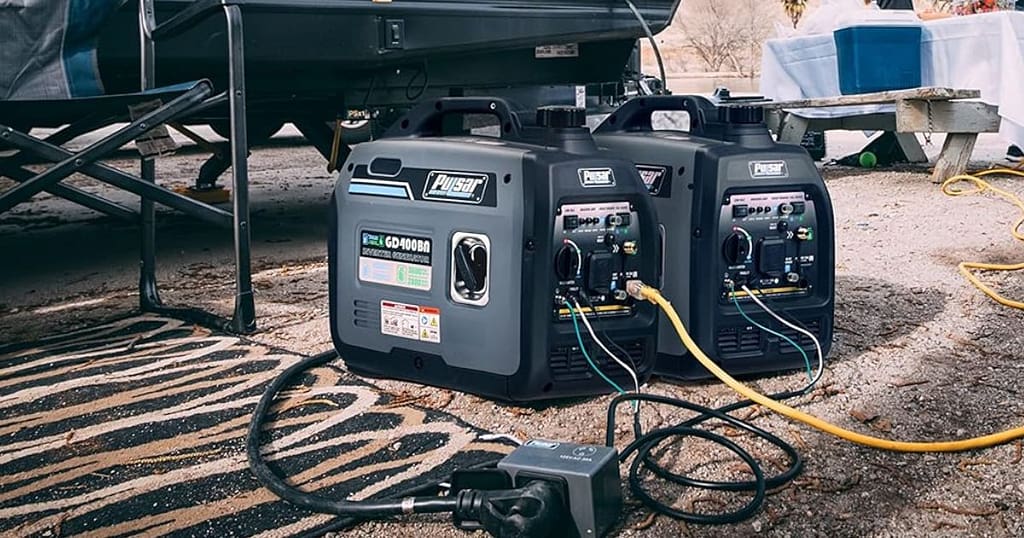Welcome to my blog on how to ground a portable generator! If you’ve ever used a portable inverter generator, you know that they can be incredibly useful during power outages, camping trips, or other outdoor activities. However, it’s important to make sure that you use your generator safely to avoid electrical shock and other hazards. One of the most important steps in using a portable generator safely is to properly ground it. In this blog, I’ll explain what grounding is, why it’s important, and provide you with step-by-step instructions on how to ground your portable generator to keep you and your loved ones safe. So let’s get started!
How to Ground a Portable Generator?
Portable generators are commonly used as a backup power source during power outages or in remote locations where access to the power grid is limited. However, operating a portable generator without proper grounding can be hazardous, as it can increase the risk of electrical shock and fire.
Grounding a portable generator involves connecting the generator to a grounding system that provides a safe path for electrical current to flow in case of a fault or surge. The grounding system typically consists of a grounding rod, grounding wire, and grounding clamp.
Here are easy steps to ground your portable generator:
Choose a location for the generator
The generator should be placed on a level, dry surface that is away from flammable materials and at least 10 feet away from buildings or structures. It should also be placed in a location where the grounding rod can be driven into the ground.
Prepare the grounding rod
A grounding rod is a metal rod that is driven into the ground to create a safe path for electrical current. To prepare the grounding rod, remove any rust or debris from the end that will be driven into the ground.
Drive the grounding rod into the ground
Using a hammer or mallet, drive the grounding rod into the ground until only a few inches of the rod are above the surface.
Connect the grounding wire
Connect one end of the grounding wire to the grounding rod by wrapping it around the rod and securing it with a grounding clamp. The other end of the grounding wire should be connected to the generator’s grounding terminal.
Test the grounding system
Use a multimeter or a ground-fault circuit interrupter (GFCI) to test the grounding system. This will ensure that there is a safe path for electrical current to flow in case of a fault or surge.
It’s important to note that grounding a portable generator is not a substitute for following other safety precautions, such as avoiding the use of extension cords or overloading the generator. Always refer to the manufacturer’s instructions for specific information on how to safely operate your portable generator.
What does mean of grounding a generator?

Grounding a generator involves connecting a grounding wire or conductor from the generator frame or casing to the ground. This is done to create a low-resistance path between the generator and the ground in case of a fault or surge in the electrical system.
When a generator is not properly grounded, electrical faults such as a short circuit or voltage surge can cause the generator to become electrically charged. This can result in dangerous situations for anyone who comes into contact with the generator, as the electrical charge can cause electrical shock, burns, and other injuries.
By grounding the generator, any electrical faults that occur will cause the excess electricity to flow through the grounding wire and into the ground, rather than building up on the generator frame. This helps to prevent electric shock and other hazards, and also protects the generator from damage.
In summary, grounding a generator is an important safety measure that should always be performed to prevent electrical hazards and protect the generator from damage.
Is the grounding of a portable generator important for every user?
Portable generators are a convenient power source for outdoor activities, camping, or during power outages. However, they can pose serious safety risks if not used properly. One of the important safety measures that every user of a portable generator should take is grounding the generator.
Grounding is the process of connecting the generator’s frame to the earth. This is done to prevent electrical shocks or electrocution from happening. When the generator is not grounded, the electricity may seek a path to the ground through a person’s body, causing severe injury or even death.
Here are some reasons why grounding of a portable generator is important for every user:
Protection against electrical shock
Grounding ensures that any electrical current that leaks from the generator to the ground is quickly and safely conducted away. This protects the user from electric shock, especially if the generator is wet, has damaged wiring, or is improperly connected to appliances.
Prevention of electrical fires
Grounding also prevents electrical fires by providing a safe path for any electrical current that might short-circuit the generator. Without grounding, a short circuit could cause an electrical fire that could spread quickly and cause serious damage to property.
Compliance with regulation
Local, state, and federal regulations may vary depending on the location and intended use of the generator. For example, if you plan to use your generator for outdoor events or construction projects, you may need to obtain permits and follow specific guidelines for noise levels and emissions. Additionally, certain areas may have restrictions on generator use during certain times of day or in certain locations.
Failure to comply with regulations can result in fines, legal action, or even injury or death. It’s important to carefully review and follow all relevant guidelines and requirements to ensure the safe and legal use of your portable generator. This may involve consulting with local authorities or professional electricians to ensure that you are meeting all necessary standards and best practices.
Protection of appliances
Grounding protects appliances that are connected to the generator by preventing voltage fluctuations and surges. These surges can damage electronic equipment, such as computers, televisions, and other appliances.
Proper functioning of the generator
Grounding ensures that the generator operates efficiently and safely. A properly grounded generator will have a more stable output voltage, reducing the risk of damage to appliances.
In summary, grounding of a portable generator is important for every user as it protects against electrical shock, prevents electrical fires, complies with regulations, protects appliances, and ensures proper functioning of the generator. Therefore, it is recommended that every user of a portable generator follows the manufacturer’s instructions for grounding the generator and consults with a qualified electrician if they have any questions or concerns.
How can I ground the generator for camping?
To ground a generator for camping, you will need to follow these steps:
- Turn off the generator and unplug any devices or appliances that are connected to it.
- Locate the grounding bolt on the generator. It should be labeled with a symbol that looks like a bolt.
- Attach a grounding rod to the grounding bolt on the generator. The grounding rod should be made of copper and should be at least 6 feet long.
- Drive the grounding rod into the ground, making sure that it is firmly in place. The ground should be moist to ensure proper grounding.
- Connect a grounding wire to the grounding rod and the grounding bolt on the generator. The wire should be at least 12-gauge copper wire.
- Run the grounding wire away from the generator and connect it to a grounding rod or metal stake that is at least 6 feet away from the generator.
- Check that the grounding wire is securely attached and that there are no loose connections.
- Turn on the generator and test it to ensure that it is working properly.
Grounding your generator is important for your safety and to protect your electrical devices from damage. By following these steps, you can ensure that your generator is properly grounded for camping.
Conclusion
In conclusion, the use of portable generators has become increasingly common in recent years, as people rely on them for power during emergencies or outdoor activities. However, without proper grounding, these generators can pose a significant risk of electrical shock or fire. Therefore, it is crucial to take the necessary precautions to ensure that your portable generator is properly grounded before use.
Through this blog, we have learned that grounding a portable generator involves creating a path of low resistance between the generator’s frame and the earth to prevent electrical shock or fires. We have also seen why proper grounding is important and how it can prevent dangerous situations.
Furthermore, the step-by-step instructions provided in this blog serve as a comprehensive guide for anyone who wants to ground their portable generator safely. By following these instructions, users can ensure that their generator is grounded correctly, reducing the risk of electrical shock and fire.
In summary, while portable generators can be an incredibly useful source of power, it is crucial to use them safely by grounding them properly. By taking the necessary precautions and following the instructions in this blog, users can enjoy the benefits of portable generators without putting themselves or their loved ones in danger.
There is a video for more clarity for you people!




